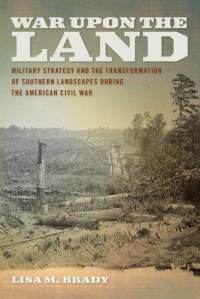reviewed by Julia Stringfellow
War Upon the Land: Military Strategy and the Transformation of Southern Landscapes during the American Civil War 
Lisa M. Brady
Athens, GA: University of Georgia Press, 2012
ISBN-13: 978-0-8203-4249-8, paperback
208 pages, $24.95
In Lisa M. Brady’s War Upon the Land, the title alone introduces the reader to the idea that there was a third side involved in the Civil War–the agricultural environment of the South. Brady’s book provides a detailed look at the American South in the midst of the Civil War and the impact of environmentalism, a widely unexplored subject until now. The author explores the idea that the Union Army was successful in defeating the Confederacy due to the environment working in their favor.
Brady’s book is a brilliant marriage of military and environmental history. The descriptions of the war-torn South produce a vivid imagining of what the South was like during the Civil War. As Brady writes, “The metaphors ‘desert,’ ‘wasteland,’ and ‘wilderness’ punctuate the written records of those who witnessed the war’s destruction, especially in those areas where the Union chevauchées occurred” (127).
As the war dragged on, the North became more acquainted with the environmental conditions of their opponent, such as constant rain, flooding, and disease-carrying insects, and learned to use these conditions to their benefit as they battled their way through the South. The most powerful ally the South had at the beginning of the war was agriculture, but that relationship steadily deteriorated as a war that was initially thought would last only a few weeks dragged on to four years. The book shows how both nature and the effects of war brought much destruction to the South.
The organization of the book’s content enhances the clarity of the subject by providing a chronological narrative of how the South prospered before the start of the war to how it was almost unrecognizable by 1865. In addition, the maps of battle sites and the famous march of the Union Army’s General William Sherman complement the text well. The extensive notes, bibliography, and index sections also greatly strengthen the content.
This book would interest environmental and military history scholars and researchers, but is also a must read for those general readers who have a keen interest in the Civil War. For these audiences, both academic and public libraries will benefit from adding this book to their collections. Because the book debuts at a key point in history as the sesquicentennial of the Civil War is being commemorated, university courses focusing on the Civil War would also benefit from the inclusion of this work.
The author, Lisa M. Brady, is an associate professor of history at Boise State University and has substantial experience in working with the subject of the Civil War and environmental history. She is currently the editor of the journal Environmental History andhas written articles and book chapters on the subject of war and nature. This is Brady’s first book, and her writing style is very approachable and engaging. It is clear she conducted extensive research in preparing this work. Given that this book is fascinating and sheds light on a topic that was previously untouched by scholars, this reviewer is eager to see what the next book by Brady will reveal.
Julia Stringfellow is an archivist/librarian and assistant professor in Special Collections and Archives at Albertsons Library, Boise State University.